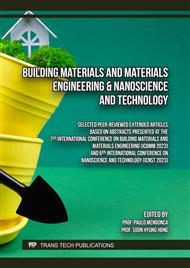p.89
p.99
p.105
p.111
p.119
p.125
p.133
p.145
p.153
Effect of Short-Term Outdoor Exposure on Fatigue Property of Japanese Cedar under Cyclic Loading
Abstract:
The wood has been focused for sustainable development goals (SDGs) of many interior products and buildings. The durability and weatherability of wood as constituent material should be investigated for the safety. In this study, the fatigue test of Japanese cedar as wood was conducted after and before outdoor exposure tests for constituent materials of interior products and buildings. The test term is one month (start time: 9/7/2020). The test place for outdoor exposure test is Hino Tokyo, Japan. As a fatigue test condition, the frequency was 10 Hz. The stress level was 70-90% of the tensile strength. As a result, the fatigue property of Japanese cedar was affected by photo degradation because constituent materials on the surface of Japanese cedar mainly received ultraviolet wave under outdoor exposure environment.
Info:
Periodical:
Pages:
119-124
Citation:
Online since:
December 2023
Authors:
Keywords:
Price:
Сopyright:
© 2023 Trans Tech Publications Ltd. All Rights Reserved
Share:
Citation:



